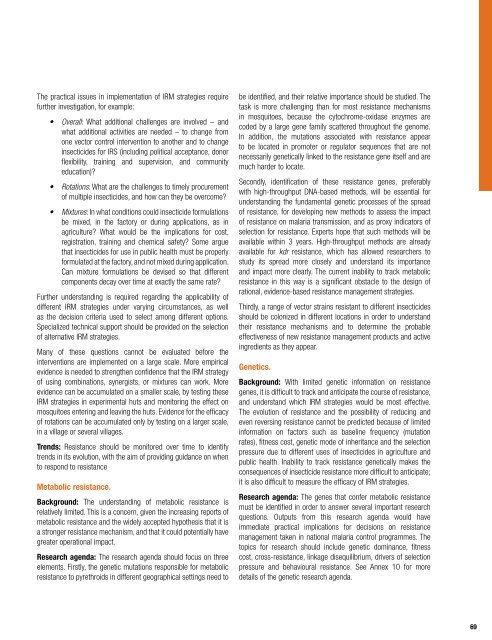Global plan for insecticide resistance management in malaria vectors
Global plan for insecticide resistance management in malaria vectors
Global plan for insecticide resistance management in malaria vectors
- No tags were found...
You also want an ePaper? Increase the reach of your titles
YUMPU automatically turns print PDFs into web optimized ePapers that Google loves.
The practical issues <strong>in</strong> implementation of IRM strategies requirefurther <strong>in</strong>vestigation, <strong>for</strong> example:• Overall: What additional challenges are <strong>in</strong>volved – andwhat additional activities are needed – to change fromone vector control <strong>in</strong>tervention to another and to change<strong><strong>in</strong>secticide</strong>s <strong>for</strong> IRS (<strong>in</strong>clud<strong>in</strong>g political acceptance, donorflexibility, tra<strong>in</strong><strong>in</strong>g and supervision, and communityeducation)?• Rotations: What are the challenges to timely procurementof multiple <strong><strong>in</strong>secticide</strong>s, and how can they be overcome?• Mixtures: In what conditions could <strong><strong>in</strong>secticide</strong> <strong>for</strong>mulationsbe mixed, <strong>in</strong> the factory or dur<strong>in</strong>g applications, as <strong>in</strong>agriculture? What would be the implications <strong>for</strong> cost,registration, tra<strong>in</strong><strong>in</strong>g and chemical safety? Some arguethat <strong><strong>in</strong>secticide</strong>s <strong>for</strong> use <strong>in</strong> public health must be properly<strong>for</strong>mulated at the factory, and not mixed dur<strong>in</strong>g application.Can mixture <strong>for</strong>mulations be devised so that differentcomponents decay over time at exactly the same rate?Further understand<strong>in</strong>g is required regard<strong>in</strong>g the applicability ofdifferent IRM strategies under vary<strong>in</strong>g circumstances, as wellas the decision criteria used to select among different options.Specialized technical support should be provided on the selectionof alternative IRM strategies.Many of these questions cannot be evaluated be<strong>for</strong>e the<strong>in</strong>terventions are implemented on a large scale. More empiricalevidence is needed to strengthen confidence that the IRM strategyof us<strong>in</strong>g comb<strong>in</strong>ations, synergists, or mixtures can work. Moreevidence can be accumulated on a smaller scale, by test<strong>in</strong>g theseIRM strategies <strong>in</strong> experimental huts and monitor<strong>in</strong>g the effect onmosquitoes enter<strong>in</strong>g and leav<strong>in</strong>g the huts. Evidence <strong>for</strong> the efficacyof rotations can be accumulated only by test<strong>in</strong>g on a larger scale,<strong>in</strong> a village or several villages.Trends: Resistance should be monitored over time to identifytrends <strong>in</strong> its evolution, with the aim of provid<strong>in</strong>g guidance on whento respond to <strong>resistance</strong>Metabolic <strong>resistance</strong>.Background: The understand<strong>in</strong>g of metabolic <strong>resistance</strong> isrelatively limited. This is a concern, given the <strong>in</strong>creas<strong>in</strong>g reports ofmetabolic <strong>resistance</strong> and the widely accepted hypothesis that it isa stronger <strong>resistance</strong> mechanism, and that it could potentially havegreater operational impact.Research agenda: The research agenda should focus on threeelements. Firstly, the genetic mutations responsible <strong>for</strong> metabolic<strong>resistance</strong> to pyrethroids <strong>in</strong> different geographical sett<strong>in</strong>gs need tobe identified, and their relative importance should be studied. Thetask is more challeng<strong>in</strong>g than <strong>for</strong> most <strong>resistance</strong> mechanisms<strong>in</strong> mosquitoes, because the cytochrome-oxidase enzymes arecoded by a large gene family scattered throughout the genome.In addition, the mutations associated with <strong>resistance</strong> appearto be located <strong>in</strong> promoter or regulator sequences that are notnecessarily genetically l<strong>in</strong>ked to the <strong>resistance</strong> gene itself and aremuch harder to locate.Secondly, identification of these <strong>resistance</strong> genes, preferablywith high-throughput DNA-based methods, will be essential <strong>for</strong>understand<strong>in</strong>g the fundamental genetic processes of the spreadof <strong>resistance</strong>, <strong>for</strong> develop<strong>in</strong>g new methods to assess the impactof <strong>resistance</strong> on <strong>malaria</strong> transmission, and as proxy <strong>in</strong>dicators ofselection <strong>for</strong> <strong>resistance</strong>. Experts hope that such methods will beavailable with<strong>in</strong> 3 years. High-throughput methods are alreadyavailable <strong>for</strong> kdr <strong>resistance</strong>, which has allowed researchers tostudy its spread more closely and understand its importanceand impact more clearly. The current <strong>in</strong>ability to track metabolic<strong>resistance</strong> <strong>in</strong> this way is a significant obstacle to the design ofrational, evidence-based <strong>resistance</strong> <strong>management</strong> strategies.Thirdly, a range of vector stra<strong>in</strong>s resistant to different <strong><strong>in</strong>secticide</strong>sshould be colonized <strong>in</strong> different locations <strong>in</strong> order to understandtheir <strong>resistance</strong> mechanisms and to determ<strong>in</strong>e the probableeffectiveness of new <strong>resistance</strong> <strong>management</strong> products and active<strong>in</strong>gredients as they appear.Genetics.Background: With limited genetic <strong>in</strong><strong>for</strong>mation on <strong>resistance</strong>genes, it is difficult to track and anticipate the course of <strong>resistance</strong>,and understand which IRM strategies would be most effective.The evolution of <strong>resistance</strong> and the possibility of reduc<strong>in</strong>g andeven revers<strong>in</strong>g <strong>resistance</strong> cannot be predicted because of limited<strong>in</strong><strong>for</strong>mation on factors such as basel<strong>in</strong>e frequency (mutationrates), fitness cost, genetic mode of <strong>in</strong>heritance and the selectionpressure due to different uses of <strong><strong>in</strong>secticide</strong>s <strong>in</strong> agriculture andpublic health. Inability to track <strong>resistance</strong> genetically makes theconsequences of <strong><strong>in</strong>secticide</strong> <strong>resistance</strong> more difficult to anticipate;it is also difficult to measure the efficacy of IRM strategies.Research agenda: The genes that confer metabolic <strong>resistance</strong>must be identified <strong>in</strong> order to answer several important researchquestions. Outputs from this research agenda would haveimmediate practical implications <strong>for</strong> decisions on <strong>resistance</strong><strong>management</strong> taken <strong>in</strong> national <strong>malaria</strong> control programmes. Thetopics <strong>for</strong> research should <strong>in</strong>clude genetic dom<strong>in</strong>ance, fitnesscost, cross-<strong>resistance</strong>, l<strong>in</strong>kage disequilibrium, drivers of selectionpressure and behavioural <strong>resistance</strong>. See Annex 10 <strong>for</strong> moredetails of the genetic research agenda.69
















